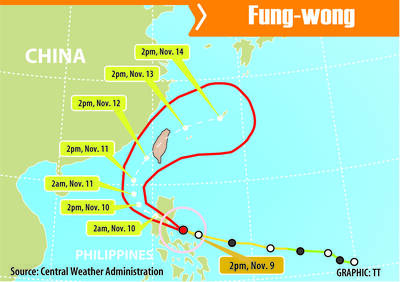Taiwan’s first two cases of locally acquired mpox (formerly known as monkeypox) were reported yesterday as the Centers for Disease Control (CDC) warned that the risk of local infection has increased.
CDC Epidemic Intelligence Center Deputy Director Guo Hung-wei (郭宏偉) said the two cases are a man in his 40s in Hsinchu and a man in his 20s in Kaohsiung.
They had symptoms including a fever, papules, blisters and swollen lymph nodes, and were diagnosed with mpox on Sunday and Monday, Guo said.

Graphic courtesy of the Centers for Disease Control
Neither man had traveled abroad recently, so they have been counted as local cases, Guo said, adding that since June 23 last year, when mpox was made a Category 2 notifiable communicable disease, seven cases have been reported, with the previous five cases being imported.
The global mpox situation has been slowing, with the WHO’s analysis of recent cases showing that the majority were young men, with 68.8 percent of transmission occurring through sexual contact.
The WHO on Feb. 15 said that mpox would remain a “public health emergency of international concern.”
The world health body in November last year said that following “a series of consultations with global experts, WHO will begin using a new preferred term ‘mpox’ as a synonym for monkeypox” and that “both names will be used simultaneously for one year while ‘monkeypox’ is phased out.”
CDC Deputy Director-General Philip Lo (羅一鈞) said that there were no connections found between the two local cases and 25 close contacts had been identified, including four family members and two intimate contacts.
The conditions of the two men would be monitored until March 20, Lo said.
CDC Division of Chronic Diseases head Chan Pei-chun (詹珮君) said that mpox is a viral zoonotic disease that has become more transmissible among humans than avian flu.
It is mainly spread through intimate contact with an infected person through bodily fluids, respiratory droplets, lesions or contaminated objects, Chan said.
Rashes often start on the face or genital area and can spread to other parts of the body, with phases including spots, blisters and scabbing, she said.
People with suspected mpox symptoms should wear a mask and wash their hands before seeking medical attention, she said, adding that they should inform their doctor about their recent travel history and contact with suspected cases.
As local cases have been reported, people should take extra precautions in high-risk locations, such as where they might have intimate contact with unfamiliar people, Chan said.
Asian nations, including Japan and Thailand, have also recently reported local mpox cases, suggesting that a rise in international travel as COVID-19 restrictions have been eased globally has allowed mpox to spread more easily across borders, Lo said.
The CDC would convene an expert panel to discuss a program of pre-exposure mpox vaccination and communicate with civic groups about prevention among high-risk groups.
Speaking on other health matters, Guo said that cases of infectious diseases reported last week included four new serious flu complications and a high level of diarrhea cases, while enterovirus cases are expected to gradually increase.

The Central Weather Administration (CWA) yesterday said it expected to issue a sea warning for Typhoon Fung-Wong tomorrow, which it said would possibly make landfall near central Taiwan. As of 2am yesterday, Fung-Wong was about 1,760km southeast of Oluanpi (鵝鑾鼻), Taiwan’s southernmost point, moving west-northwest at 26kph. It is forecast to reach Luzon in the northern Philippines by tomorrow, the CWA said. After entering the South China Sea, Typhoon Fung-Wong is likely to turn northward toward Taiwan, CWA forecaster Chang Chun-yao (張峻堯) said, adding that it would likely make landfall near central Taiwan. The CWA expects to issue a land

The Central Weather Administration (CWA) yesterday said it is expected to issue a sea warning for Typhoon Fung-wong this afternoon and a land warning tomorrow. As of 1pm, the storm was about 1,070km southeast of Oluanpi (鵝鑾鼻), Taiwan’s southernmost point, and was moving west-northwest at 28 to 32kph, according to CWA data. The storm had a radius of 250km, with maximum sustained winds of 173kph and gusts reaching 209kph, the CWA added. The storm is forecast to pass near Luzon in the Philippines before entering the South China Sea and potentially turning northward toward Taiwan, the CWA said. CWA forecaster Chang Chun-yao (張峻堯) said

PREPARATION: Ferry lines and flights were canceled ahead of only the second storm to hit the nation in November, while many areas canceled classes and work Authorities yesterday evacuated more than 3,000 people ahead of approaching Tropical Storm Fung-wong, which is expected to make landfall between Kaohsiung and Pingtung County this evening. Fung-wong was yesterday morning downgraded from a typhoon to a tropical storm as it approached the nation’s southwest coast, the Central Weather Administration (CWA) said, as it issued a land alert for the storm. The alert applies to residents in Tainan, Kaohsiung, Pingtung and Taitung counties, and the Hengchun Peninsula (恆春). As of press time last night, Taichung, Tainan, Kaohsiung, and Yilan, Miaoli, Changhua, Yunlin, Pingtung and Penghu counties, as well as Chiayi city and county had

The Central Weather Administration (CWA) yesterday issued a sea alert for Typhoon Fung-wong (鳳凰) as it threatened vessels operating in waters off the Pratas Islands (Dongsha Islands, 東沙群島), the Bashi Channel and south of the Taiwan Strait. A land alert is expected to be announced some time between late last night and early this morning, the CWA said. As of press time last night, Taoyuan, as well as Yilan, Hualien and Penghu counties had declared today a typhoon day, canceling work and classes. Except for a few select districts in Taipei and New Taipei City, all other areas and city